-
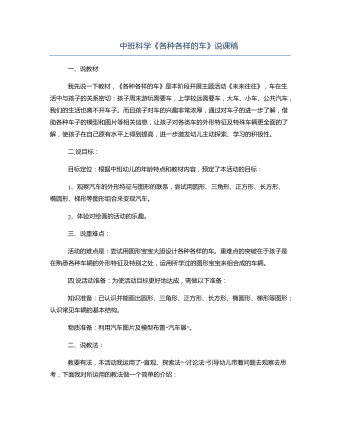
中班科学《各种各样的车》说课稿
教要有法,本活动我运用了“直观、探索法”“讨论法”引导幼儿带着问题去观察去思考,下面我对所运用的教法做一个简单的介绍:1.直观、探索法:利用参观“车展”让幼儿更直观去观察各种各样的车,让幼儿通过视、触觉获取有关汽车种类和功能。更直观了解各种各样车的外形特征,帮助幼儿提升原有的经验,又为后面的绘画做好知识准备。2.讨论法:幼儿通过交流各种各样的车达到共同学习,通过讨论充分发表对汽车的外形特征及功能。引导幼儿通过自由和集中交流,大胆和同伴、老师对自己所了解的各种各样的汽车进行交流讨论,使幼儿的认知、语言表达能力得到有效的提高。
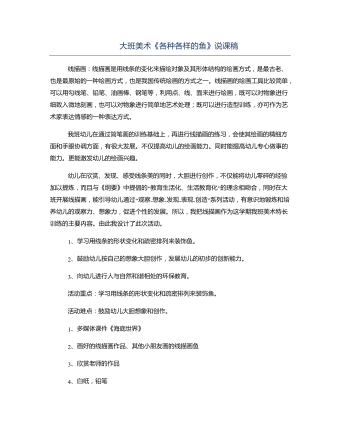
大班美术《各种各样的鱼》说课稿
幼儿在欣赏、发现、感受线条美的同时,大胆进行创作,不仅能将幼儿零碎的经验加以提炼,而且与《纲要》中提倡的“教育生活化、生活教育化”的理念相吻合,同时在大班开展线描画,能引导幼儿通过“观察-想象-发现-表现-创造”系列活动,有意识地锻炼和培养幼儿的观察力、想象力,促进个性的发展。所以,我把线描画作为这学期我班美术特长训练的主要内容。由此我设计了此次活动。1、学习用线条的形状变化和疏密排列来装饰鱼。2、鼓励幼儿按自己的想象大胆创作,发展幼儿的初步的创新能力。3、向幼儿进行人与自然和谐相处的环保教育。活动重点:学习用线条的形状变化和疏密排列来装饰鱼。活动难点:鼓励幼儿大胆想象和创作。
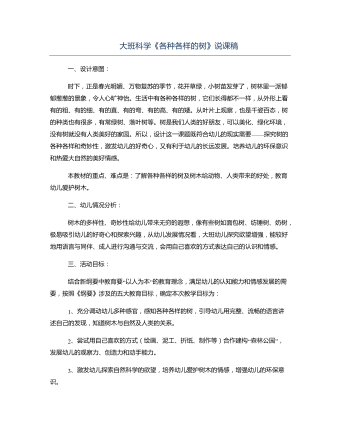
大班科学《各种各样的树》说课稿
时下,正是春光明媚、万物复苏的季节,花开草绿,小树苗发芽了,树林里一派郁郁葱葱的景象,令人心旷神怡。生活中有各种各样的树,它们长得都不一样,从外形上看有的粗、有的细、有的直、有的弯、有的高、有的矮。从叶片上观察,也是千姿百态,树的种类也有很多,有常绿树、落叶树等。树是我们人类的好朋友,可以美化、绿化环境,没有树就没有人类美好的家园。所以,设计这一课题既符合幼儿的现实需要——探究树的各种各样和奇妙性,激发幼儿的好奇心,又有利于幼儿的长远发展。培养幼儿的环保意识和热爱大自然的美好情感。本教材的重点、难点是:了解各种各样的树及树木给动物、人类带来的好处,教育幼儿爱护树木。
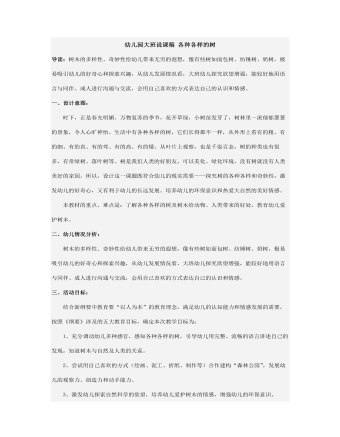
幼儿园大班说课稿 各种各样的树
时下,正是春光明媚、万物复苏的季节,花开草绿,小树苗发芽了,树林里一派郁郁葱葱的景象,令人心旷神怡。生活中有各种各样的树,它们长得都不一样,从外形上看有的粗、有的细、有的直、有的弯、有的高、有的矮。从叶片上观察,也是千姿百态,树的种类也有很多,有常绿树、落叶树等。树是我们人类的好朋友,可以美化、绿化环境,没有树就没有人类美好的家园。所以,设计这一课题既符合幼儿的现实需要——探究树的各种各样和奇妙性,激发幼儿的好奇心,又有利于幼儿的长远发展。培养幼儿的环保意识和热爱大自然的美好情感。 本教材的重点、难点是:了解各种各样的树及树木给动物、人类带来的好处,教育幼儿爱护树木。
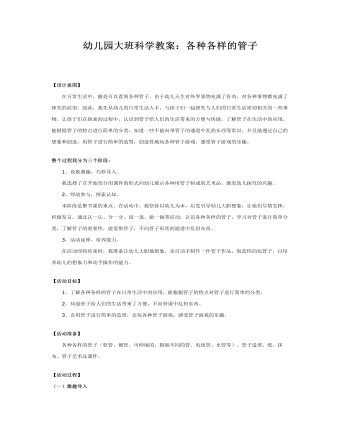
大班科学教案:各种各样的管子
整个过程我分为三个阶段:1、设疑激趣,巧妙导入。 我选择了在开始部分用课件的形式向幼儿展示各种用管子制成的艺术品,激发幼儿探究的兴趣。2、师幼参与,探索认知。 本阶段是整节课的重点。在活动中,我坚持以幼儿为本,启发引导幼儿大胆想象,让他们尽情发挥,积极发言。通过认一认、分一分、说一说、做一做等活动,认识各种各样的管子,学习对管子进行简单分类,了解管子的重要性,能爱惜管子,不向管子形状的通道中乱扔东西。3、活动延伸,培养能力。 在活动即将结束时,我准备让幼儿大胆地想象,亲自动手制作一件管子作品,创造性的玩管子,以培养幼儿的想象力和动手操作的能力。【活动目标】1、了解各种各样的管子在日常生活中的应用,能根据管子的特点对管子进行简单的分类。2、知道管子给人们的生活带来了方便,不向管道中乱扔东西。3、会用管子进行简单的造型,会玩各种管子游戏,感受管子游戏的乐趣。
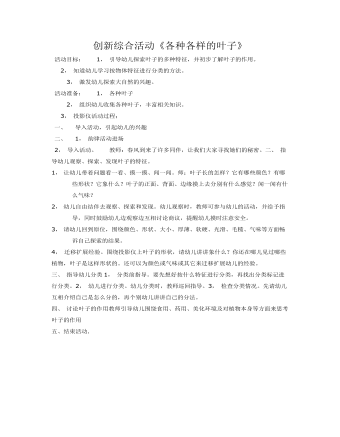
大班科学教案:各种各样的叶子
一、 导入活动,引起幼儿的兴趣 二、 1,韵律活动进场 2,导入活动。 教师:春风到来了许多同伴,让我们大家寻找她们的秘密。二、指导幼儿观察、探索、发现叶子的特征。 1, 让幼儿带着问题看一看、摸一摸、闻一闻。师;叶子长的怎样?它有哪些颜色?有哪些形状?它象什么?叶子的正面、背面、边缘摸上去分别有什么感觉?闻一闻有什么气味?
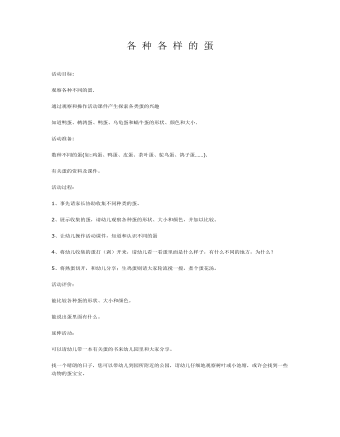
中班科学课件教案:各种各样的蛋
通过观察和操作活动课件产生探索各类蛋的兴趣 知道鸭蛋、鹌鹑蛋、鸭蛋、乌龟蛋和蜗牛蛋的形状、颜色和大小. 活动准备: 数种不同的蛋(如:鸡蛋、鸭蛋、皮蛋、茶叶蛋、鸵鸟蛋、鸽子蛋……).有关蛋的资料及课件。 活动过程: 1、事先请家长协助收集不同种类的蛋。 2、展示收集的蛋,请幼儿观察各种蛋的形状、大小和颜色,并加以比较。 3、让幼儿操作活动课件,知道和认识不同的蛋 4、将幼儿收集的蛋打(剥)开来,请幼儿看一看蛋里面是什么样子,有什么不同的地方,为什么? 5、将熟蛋切开,和幼儿分享;生鸡蛋则请大家轮流搅一搅,煮个蛋花汤。 活动评价: 能比较各种蛋的形状、大小和颜色。 能说出蛋里面有什么。 延伸活动: 可以请幼儿带一本有关蛋的书来幼儿园里和大家分享。 找一个晴朗的日子,您可以带幼儿到园所附近的公园,请幼儿仔细地观察树叶或小池塘,或许会找到一些动物的蛋宝宝。
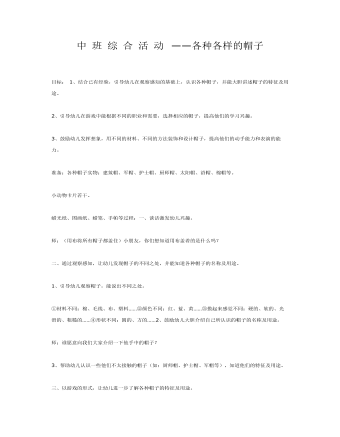
中班综合教案各种各样的帽子
2、引导幼儿在游戏中能根据不同的职业和需要,选择相应的帽子,提高他们的学习兴趣。3、鼓励幼儿发挥想象,用不同的材料、不同的方法装饰和设计帽子,提高他们的动手能力和表演的能力。准备:各种帽子实物:建筑帽、军帽、护士帽、厨师帽、太阳帽、浴帽、棉帽等。 小动物卡片若干。蜡光纸、图画纸、蜡笔、手帕等过程:一、谈话激发幼儿兴趣。师:(用布将所有帽子都盖住)小朋友,你们想知道用布盖着的是什么吗? 二、通过观察感知,让幼儿发现帽子的不同之处,并能知道各种帽子的名称及用途。1、引导幼儿观察帽子,能说出不同之处。①材料不同:棉、毛线、布、塑料……②颜色不同:红、蓝、黄……③摸起来感觉不同:硬的、软的、光滑的、粗糙的……④形状不同:圆的、方的……2、鼓励幼儿大胆介绍自己所认识的帽子的名称及用途。
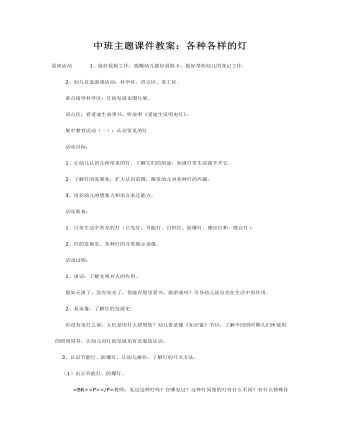
中班主题课件教案:各种各样的灯
2、幼儿自选游戏活动:科学区、语言区、美工区。 重点指导科学区:灯的发展史图片展。 语言区:看爱迪生故事书,听故事《爱迪生发明电灯》。 集中教育活动(一):认识常见的灯 活动目标: 1、让幼儿认识几种常见的灯,了解它们的用途,知道日常生活离不开它。 2、了解灯的发展免,扩大认识范围,激发幼儿对各种灯的兴趣。 3、培养幼儿的想象力和语言表达能力。 活动准备: 1、日常生活中常见的灯(日光灯、节能灯、白炽灯、防爆灯、感应灯和一般台灯)。 2、灯的发展史、各种灯的分类展示录像。 活动过程: 1、谈话:了解光明对人的作用。 假如天黑了,没有亮光了,你能在屋里看书、做游戏吗?引导幼儿说出光在生活中的作用。 2、看录像,了解灯的发展史。 有没有电灯之前,人们是用什么照明的?幼儿看录像《知识窗》节目,了解不同的时期人们所使用 的照明用具,让幼儿对灯的发展史有直观的认识。 3、认识节能灯、防爆灯,让幼儿操作,了解灯的开关方法。 (1)出示节能灯、防爆灯。 教师:见过这种灯吗?在哪见过?这种灯同别的灯有什么不同?有什么特殊作用? (2)你知道怎样才能使它们亮起来吗?(通电打开开关)请幼儿实际操作将活动室的灯打开、关上。 (3)幼儿探索尝试感应台灯和一般台灯开关方法的不同。
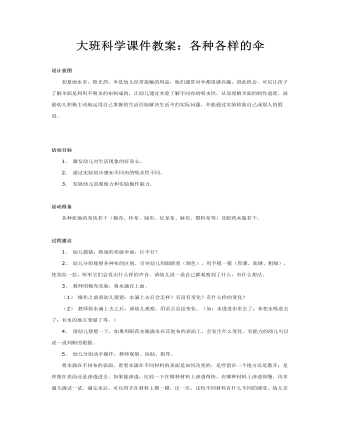
大班科学课件教案:各种各样的伞
活动目标1、激发幼儿对生活现象的好奇心。2、通过实验初步感知不同布的吸水性不同。3、发展幼儿的观察力和实验操作能力。 活动准备 各种质地的布块若干(棉布、纱布、绒布、尼龙布、麻布、塑料布等)及眼药水瓶若干。 过程建议1、幼儿猜猜:换别的布做伞面,行不行?2、幼儿分组观察各种布的区别。引导幼儿用眼睛看(颜色),用手摸一摸(厚薄、软硬、粗细),使劲拉一拉,听听它们会发出什么样的声音。请幼儿说一说自己都观察到了什么,有什么想法。
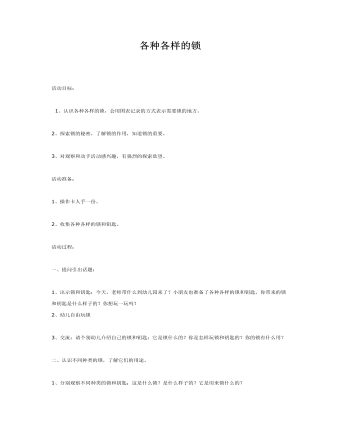
中班科学各种各样的锁课件教案
2、探索锁的秘密,了解锁的作用,知道锁的重要。3、对观察和动手活动感兴趣,有强烈的探索欲望。活动准备:1、操作卡人手一份。2、收集各种各样的锁和钥匙。活动过程:一、提问引出话题:1、出示锁和钥匙:今天,老师带什么到幼儿园来了?小朋友也准备了各种各样的锁和钥匙,你带来的锁和钥匙是什么样子的?你想玩一玩吗?2、幼儿自由玩锁
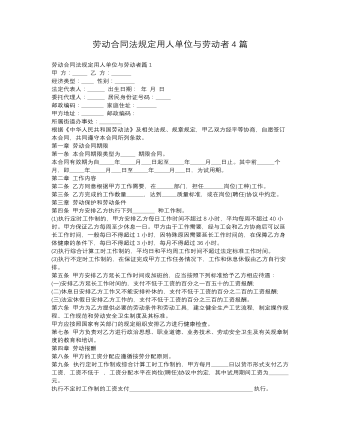
劳动合同法规定用人单位与劳动者4篇
第二章 工作内容第二条 乙方同意根据甲方工作需要,在_______部门,担任________岗位(工种)工作。第三条 乙方完成的工作数量_______,达到______质量标准,或在岗位(聘任)协议中约定。第三章 劳动保护和劳动条件第四条 甲方安排乙方执行下列_________ 种工作制。(1)执行定时工作制的,甲方安排乙方每日工作时间不超过8小时,平均每周不超过40小时。甲方保证乙方每周至少休息一日。甲方由于工作需要,经与工会和乙方协商后可以延长工作时间,一般每日不得超过1小时,因特殊原因需要延长工作时间的,在保障乙方身体健康的条件下,每日不得超过3小时,每月不得超过36小时。(2)执行综合计算工时工作制的,平均日和平均周工作时间不超过法定标准工作时间。(3)执行不定时工作制的,在保证完成甲方工作任务情况下,工作和休息休假由乙方自行安排。
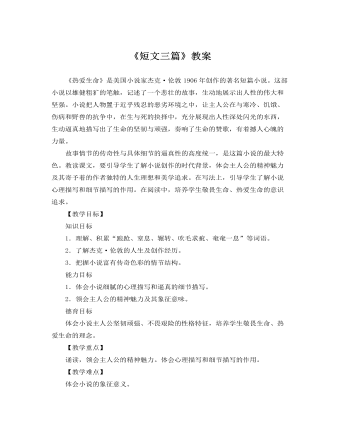
人教版高中语文必修4《短文三篇》教案
③于是,大自然出现了惊人的奇迹,不毛的石缝间丛生出倔强的生命。④或者就只是一簇一簇无名的野草,春绿秋黄。岁岁枯荣。它们只有三两片长长的细瘦的薄叶,那细微的叶脉,告知你生存该是多么艰难;更有的。它们就在一簇一簇瘦叶下自己生长出根须,只为了少向母体吮吸一点乳汁,便自去寻找那不易被觉察到的石缝。这就是生命,如果这是一种本能,那么它正说明生命的本能是多么尊贵,生命有权自认为辉煌壮丽,生机竟是这样地不可扼制。⑤或者就是一团一团小小的山花,大多又都是那苦苦的蒲公英。它们不似田野上的同宗长得那样茁壮,它们的茎显得坚韧而苍老。它们的叶因枯萎而失却光泽。它们已经不能再去为人们作佐餐的鲜嫩的野菜,却默默地为攀登山路的人准备了一个可靠的抓手。生命就这样地被环境规定着,又被环境改变着,适者生存的规律尽管无情。但一切适者就是战胜环境的强者。生命现象告诉你,生命就是拼搏。

人教版高中英语必修4A taste of English Humor说课稿3篇
Then I would ask them to think of a funny English or Chinese and tell it to partners. While telling stories, they can use expressions and some acting to help make the story funny. 5 minutes would be given to do this.Those stories they told there will be the material for their writing. Soletting them tell it at first is helpful. And they can make a difference between telling a funny story and writing it down. Generally speaking, it is difficult forstudents to write well because they don’t know what to write and how to write. Asking them to tell their own stories at first can help them come up with what to write.After their telling, I would invite someone to share his/her story with all of us and I would write it down on the blackboard.This example story would be used as a sample to illustrate the format of funny story. Different from a story from teacher or textbook, a story from students can obviously become a interesting material to draw students’ attention.Then I would ask the whole class to put this story into several parts. It might be a little bit difficult for them. So I would ask them to find out whether all the sentences are necessary. After delete some sentences, there are 6 sentences left behind. Then they can easily put them into three parts. After interaction with students, I would teach them the right terms for each part and conclude the format of funny story.This step is the key and difficult point in my lesson. So I mainly usetask-based teaching method in this part and the task for students was divided into several stages. With the separated difficult level, students can find there are usually three parts in writing. They can also learn to write without the unnecessary parts in the process of analyzing. And then I wouldn’t rush to tell them the right terms to them directly. Instead, I would ask them to name them by their own. A confused mind is better for acquiring knowledge.While-writing:Then I would give students 7 minutes to write down this story, without other requirements.With all the preparations in pre-writing, students’ difficulties were cleared. So it would be much easier for them to write down the story within 7 minutes. There are no other requirements because students’ first writing is actually a drafting. It would be revise and edit several times later. Writing, as a skill

人教版高中英语必修3Canada-the true north说课稿4篇
Good afternoon, teachers, It’s my great pleasure to be here sharing my lesson with you.The content of my lesson is Senior English Book 3 Unit 5 Canada —— “The true North”.I’ll be ready to begin this lesson from five parts. Analysis of the teaching material,the teaching methods,the studying methods, the teaching procedure,and Blackboard design.First, let me talk about the teaching material.Part 1 Teaching Material:This unit is about the introduction of Canada. By studying of this unit,we’ll enable the students to learn the geography, population, main cities, and natural beauty, natural resources of Canada. Through the training of the unit, it also requires students to learn some Language skills such as the expressions of position and emotions.So it plays an important part in the English teaching in this book.After studying the teaching material and analyzing the rule of children’s growing of mind,I think the teaching aims are the followings:1.Knowledge objects:(1) make the students learn some new words and phrases(2) make the students understand the content of the lesson.2.Ability objects:(1)To develop the Ss’ abilities of listening, speaking, reading and writing. Especially reading and speaking ability.(2) learn to talk about the characters of Canada in English(3)To train the Ss’ ability of working in pairs.3.Emotion objects:(1)Enable students to understand the characters of Canada..(2)Stimulate Ss to work hard to make China stronger.Part 2 Teaching Methods:I think helping students learn to master new words and phrases and improve the students’ reading and speaking ability is import and the difficult.According to the analysis of the teaching material and the import points and the difficult points,I will use the following teaching methods : question-guiding approach; fast-reading and careful reading; multi-media teaching methods; discussion

人教版高中英语必修4Theme parks说课稿3篇
The oldest and the most popular park in the worldenjoy the exciting activities thereget close to the life-size cartoon characters like Mickey Mouse and Donald Duck Step 3 Pre-reading1.What do you suppose a theme park is ?2.What do you think you can see in a theme park?(1.It is a kind of amusement park which has a certain theme – that the whole park is based on. 2.buildings, castles, statues, rare animals and birds, and so on.) Step 4 Reading ----- Theme Parks –---- Fun and More Than Fun1.Predict : Read the title and the pictures on P. 34 and PredictWhat is the meaning of the title “Theme Park – Fun and more than fun”?(The title means that theme parks are fun to visit, but that they can also be educational and can offer useful information.)2.Skimming Fast read and answer:What activities can we take in a theme park?Amusement park: Bumper car Merry-go-round slide bungee jumping Free-fall rides Horror films Pirate ship Ferris wheel roller coaster3.Scanning Read again and you will find various theme parks are mentioned in the passage . Then what are they ?Theme parks: Sports theme park History theme park Culture theme park Marine or Ocean theme Park Future park Science theme park Disneyland4.Careful reading and find the main idea of each paragraph:THEME PARKS---- entertaining/ educationalPara.1 Traditional parks are places to go for relaxation and to have time away from our busy lives.Para.2 Theme parks are different They’re large and full of things to do, see and buy.Para.3 Theme parks are built around a single idea or theme. One example is a sports park.Para.4 Another kind of theme park is historical more and cultural and can be educational.Para.5 Disneylandwas the first theme park. It is based on the fantasy life and characters of Disney’s films.Para.6 Some examples of educational theme parks include sea world parks and science parks.

人教版高中英语必修3Healthy Eating说课稿4篇
Language learning needs a context, which can help the learners to understand the language and then can product comprehensible output, so computer has the advantages to make the materials attractive.Part 3 Learning MethodsTask-based, self-dependent and cooperative learningPart 4 Teaching ProcedureStep One Lead-in“Interest is the best teacher.” Therefore, at the very beginning of the class, I should spark the students’ mind to focus on the centre topic “the band”. I’ll show some pictures of food to attract their attention and then bring some questions.Question:What kind of food they like?What should go into a good meal?The answers must relate to the diet. After this, the students will be eager to know something about a balance diet and this is the very time to naturally lead the class into Step 2Step 2 Reading for information: skimming and scanning In this step, I use Task-based Language Teaching method, which can give students a clear and specific purpose while skimming and scanning the context.Task 1 General ideaThe students will be asked to just glance at the title and the pictures of the passage, and then guess what they will read in the text. And they’ll be divided into groups of four to have a discussion.The purpose is to inspire the students to read actively, not passively. In addition, the task is to develop the students’ reading skill by making prediction and to encourage the students to express their thoughts in English and cooperate with each other.Task 2 Main idea of each paragraphCooperative learning can raise the students’ interest and create an atmosphere of achievement. Based on this theory, I divide the whole class into 4 groups to skim the whole text and get the main idea of each paragraph.

人教版高中英语必修4Working The Land说课稿3篇
Knowledge objectives:(1) to make Ss grasp the usage of words, expressions and sentence structures: statistics, struggle, thanks to, rid of, some patterns for persuasion, the “ing” form as subject and object;(2)to use learnt knowledge to persuade sb.Ability objectives:(1) to develop Ss’ reading skills(skimming, scanning, word guessing);(2) to improve Ss’ speaking, communicating and cooperating skills.Emotional objectives:to make Ss know the contribution of Yuan,and learn his spirit and his simple life time.Teaching important and difficult points:(1) some words, expressions and sentence structures mentioned above;(2)the content of the text;(3)training their reading and speaking skills.Teaching methods: CLT, TBLT,QT.Learning strategies: CLS, QLS, TBLS.Teaching procedures:Step 1 lead-in: (1) teacher plays a piece of recent news from CCTV about the harvest of the super hybrid rice, and ask students whether they know Yuan or not, and talk about him and his contribution.(2)Brain storm: let Ss describe Yuan in their minds including his appearance, his living condition and so on.Step 2 fast reading tasks:(1)teacher introduces Yuan and super hybrid rice(2)make Ss read the text as fast as possible with questions. Such as: what’s the general ideaof this passage? What’s Yuan’ dream? (skimming and scanning skill)Step 3 intensive reading tasks(1)let Ss read the text silently, find topic sentence of each paragraph and draw the difficult sentences and the knowledge what they don’t understand.(words guessing)(2)teacher and Ss talk about the important words, expressions and sentences together, and ask Ss to retell the content of the text.(summarizing and paraphrasing)(3)teacher summarize this part.(4) read again following the courseware.

人教版高中英语必修5Great scientists说课稿4篇
通过写文章梗概,培养学生综合运用语言的能力,学习用恰当的英语描述科学家的故事。这是本课的教学难点。教师可以使用完形填空的方式来帮助学生整理语篇,从而来降低难度。本课的教学重点的突破方法是:在阅读前,让学生初步了解得出科学观点所需要的基本程序,从而轻松而自然地导入文章的阅读;在阅读过程中,由易到难设计快速阅读和精读的问题,层层推进各种阅读活动,让学生对阅读内容从整体感知到细节理解,最后深层读懂整篇文章,同时加强阅读策略的指导,让每个学生都主动参与课堂教学活动,最终达到提高阅读能力的目的。Step 4 Post-readingGroup Activities四人小组共同合作,在老师的适当指导下,就以下2个问题展开讨论,让学生就所知、所学、所感和所想融入话题,然后抽若干同学代表作小组发言。1. What do you think about John Snow, and what should we learn from him?2. Cholera was 19th century disease, which two diseases are similar to cholera today? Why?

人教版高中英语必修5Making the news说课稿4篇
今天我们来介绍一下必修五第四单元的授课方式。这个单元的题目是Making the news。应该是学生比较感兴趣的话题,学生往往对新闻工作充满好奇,所以我们可以利用这个机会多设计一些师生互动和学生互动,来激发起学习的积极性,提高学习效率。同时我们可以利用这个单元不仅帮助学生掌握语言知识,培养语言能力,同时让其了解新闻工作的重要性,培养起社会智能感。这个单元分为六个课时,它的教学目标是这样的:语言目标是掌握词汇表中的常用单词和短语,掌握倒装句的一些基本用法。 技能目标是能初步掌握约会的基本句型并在真实的场景下正确运用。新闻报道类文章的写作技能。采访的基本规范和沟通技能。情感目标是对新闻报道的客观性和真实性有更好的理解。对新闻记者的职业有更深入的了解,并能体会其工作的重要性。下面我们来介绍一下第一课时的授课方式,第一课的教学目标是这样的第一课时的教学目标语言目标:单词:Occupation, journalist, editor, photographer, curious, personality, enthusiasm